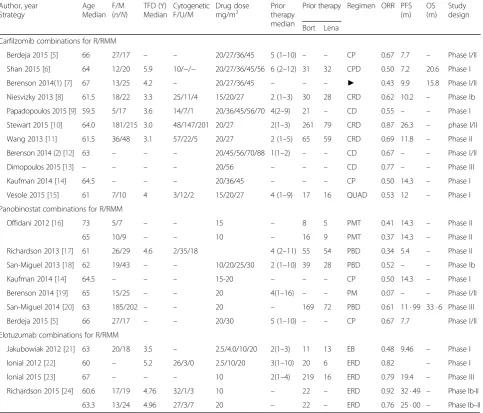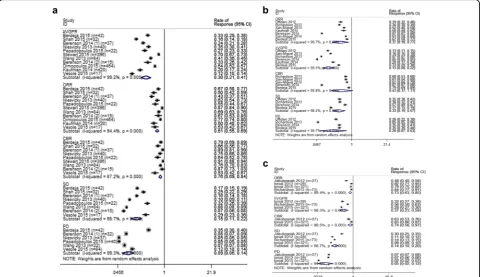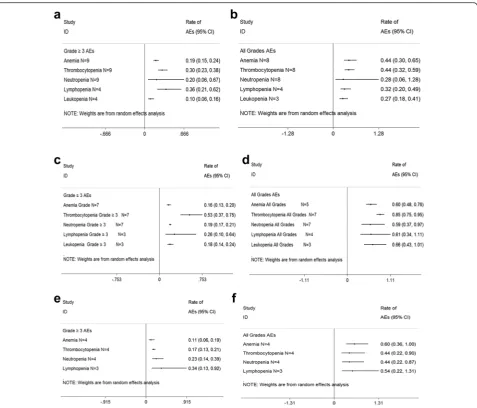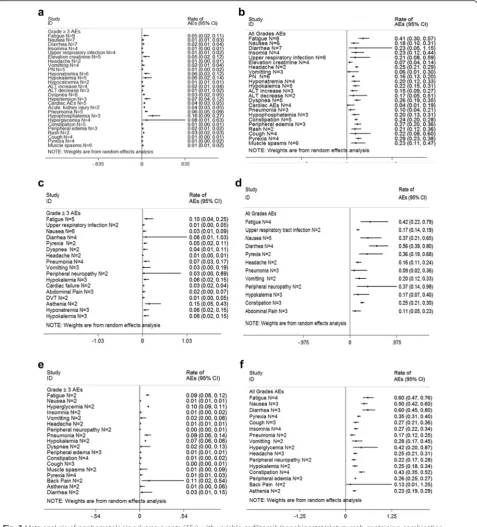L E T T E R T O T H E E D I T O R
Open Access
Pooled analysis of the reports of
carfilzomib, panobinostat, and elotuzumab
combinations in patients with refractory/
relapsed multiple myeloma
Liping Liu
1, Ningning Zhao
1, Wenjun Xu
1, Zhixin Sheng
1and Lida Wang
2*Abstract
Purpose:
The purpose of this study was to better understand the efficacy and safety of carfilzomib, panobinostat,
and elotuzumab combinations in patients with refractory/relapsed multiple myeloma(R/RMM).
Methods:
We retrieved and reviewed published reports including carfilzomib, panobinostat, and elotuzumab
combination regimens for patients with R/RMM.
Results:
We identified 20 prospective studies that evaluated 2220 patients. Carfilzomib combination regimens
produced an overall response rate (ORR
≥
PR) of 61 % in the 1211 relapsed/refractory patients. At least very good
partial response (VGPR) was 29 % in patients with carfilzomib combinations. Finally, 49 % of the 597 patients
achieved ORR in patients receiving panobinostat-containing combinations. At least VGPR was 16 % in patients with
panobinostat combinations. Three hundred twenty-eight of these 449 patients (73 %) receiving
elotuzumab-containing combinations achieved ORR. And at least VGPR was 37 %. And, the vital nonhematologic adverse events
(AEs) were cardiac events and pneumonia.
Conclusion:
Carfilzomib, panobinostat, and elotuzumab combination regimens produced clinical benefits in
patients with R/RMM.
Keywords:
Carfilzomib, Panobinostat, Elotuzumab, Multiple myeloma
Abbreviations:
R/RMM, Refractory/relapsed multiple myeloma; ORR, Overall response rate; VGPR, Very good partial
response rate; CBR, Clinical benefit rate; SDR, Stable disease rate; PDR, Progressive disease rate; CFZ, Carfilzomib;
PAN, Panobinostat; ELO, Elotuzumab; DEX, Dexamethasone; BOR, Bortezomib; LEN, Lenalidomide
To the editor
Relapsed myeloma disease is characterized by
increas-ingly lower remission rate even following salvage therapy
[1]. So, there is still an urgent need for new treatments to
improve the outcomes of such patients. Carfilzomib (CFZ;
a selective proteasome inhibitor), panobinostat (PAN; a
pan-deacetylase inhibitor), and elotuzumab (ELO; a fully
humanized monoclonal antibody against CS1 with
signifi-cant anti-myeloma activity) are potent anti-myeloma agents
with different mechanisms of action [2
–
4]. We conducted a
pooled analysis to determine the efficacy and safety of
carfilzomib, panobinostat, and elotuzumab combination
regimens in these patients with relapsed/refractory multiple
myeloma (R/RMM). The primary outcomes of the analysis
were the overall response rate (ORR
≥
PR), at least
very good partial response (VGPR), clinical benefit
rate (CBR
≥
MR), stable disease rate (SDR), and
pro-gressive disease rate (PDR). Statistical analysis method
has been shown in Appendix 1.
We identified 20 prospective studies that evaluated 2220
patients with R/RMM receiving carfilzomib-, panobinostat-,
or elotuzumab-containing combinations [5
–
24]. Table 1
summarizes the characteristics of 20 identified clinical
re-ports. As shown in Fig. 1a, 351 of 1211 response-evaluable
R/RMM patients (29 %) who received carfilzomib
* Correspondence:452697850@qq.com2E.N.T. Department, Weifang People’s Hospital, Weifang, China
Full list of author information is available at the end of the article
combination therapy in 12 trials achieved at least a VGPR,
and 739 patients (61 %) achieved OR. And 727 patients
were evaluable for CBR analysis, and CBR was 74 %. And
subgroup analysis indicated that the combination of
carfil-zomib and dexamethasone (DEX) achieved an ORR of
83 %, at least VGPR of 49 %, in those 533 response
evalu-able patients; in those 520 response evaluevalu-able patients, the
ORR of 89 % derived from CRD (CFZ/LEN/DEX)
com-pares favorably with that of 66.7 % from RD (LEN/DEX)
[10]. Furthermore, the addition of carfilzomib to
lenalido-mide (LEN) and dexamethasone could improve
progres-sion free survival by 31 % [10].
Sensitivity analyses shown that the combination of
panobinostat and melphalan regimen [19] differed much
from the others, which contribute most to the
hetero-geneity. In order to strengthen the reliability of this
pooled analysis, we exclude this trial. When excluding
this trial, as shown in Fig. 1b, 49 % of the 597 evaluable
R/RMM patients treated with panobinostat-containing
combination regimens achieved an ORR, at least VGPR
was achieved by 16 %, CBR by 66 %, the SDR was 28 %,
and the PDR was 17 %. In those 504 response evaluable
patients, the ORR of 48 % derived from PBD (PAN/
BOR/DEX) regimen seems to be higher than that of
bor-tezomib (BOR)-containing therapy in a similar
popula-tion [25]. Furthermore, the addipopula-tion of panobinostat to
bortezomib and dexamethasone could reduce the risk of
disease progression by 37 % [20].
Table 1
Characteristics of included studies
Author, year Strategy
Age Median
F/M (n/N)
TFD (Y) Median
Cytogenetic F/U/M
Drug dose
mg/m2 Priortherapy
median
Prior therapy Regimen ORR PFS (m)
OS (m)
Study design
Bort Lena
Carfilzomib combinations for R/RMM
Berdeja 2015 [5] 66 27/17 – – 20/27/36/45 5 (1–10) – – CP 0.67 7.7 – Phase I/II
Shan 2015 [6] 64 12/20 5.9 10/−/− 20/27/36/45/56 6 (2–12) 31 32 CPD 0.50 7.2 20.6 Phase I
Berenson 2014(1) [7] 67 13/25 4.2 – 20/27/36/45 – – – ► 0.43 9.9 15.8 Phase I/II
Niesvizky 2013 [8] 61.5 18/22 3.3 25/11/4 15/20/27 2 (1–3) 30 28 CRD 0.62 10.2 – Phase Ib
Papadopoulos 2015 [9] 59.5 5/17 3.6 14/7/1 20/36/45/56/70 4(2–9) 21 – CD 0.55 – – Phase I
Stewart 2015 [10] 64.0 181/215 3.0 48/147/201 20/27 2(1–3) 261 79 CRD 0.87 26.3 – phase I/II
Wang 2013 [11] 61.5 36/48 3.1 57/22/5 20/27 2 (1–5) 65 59 CRD 0.69 11.8 – Phase II
Berenson 2014 (2) [12] 63 – – – 20/45/56/70/88 1(1–2) – – CD 0.67 – – Phase I/II
Dimopoulos 2015 [13] – – – – 20/56 – – – CD 0.77 – – Phase III
Kaufman 2014 [14] 64.5 – – – 20/36/45 – – – CP 0.50 14.3 – Phase I
Vesole 2015 [15] 61 7/10 4 3/12/2 15/20/27 4 (1–9) 17 16 QUAD 0.53 12 – Phase I
Panobinostat combinations for R/RMM
Offidani 2012 [16] 73 5/7 – – 15 – 8 5 PMT 0.41 14.3 – Phase II
65 10/9 – – 10 – 16 9 PMT 0.37 14.3 – Phase II
Richardson 2013 [17] 61 26/29 4.6 2/35/18 4 (2–11) 55 54 PBD 0.34 5.4 – Phase II
San-Miguel 2013 [18] 62 19/43 – – 10/20/25/30 2 (1–10) 39 28 PBD 0.52 – – Phase Ib
Kaufman 2014 [14] 64.5 – – – 15-20 – – – CP 0.50 14.3 – Phase I
Berenson 2014 [19] 65 15/25 – – 20 4(1–16) – – PM 0.07 – – Phase I/II
San-Miguel 2014 [20] 63 185/202 – – 20 – 169 72 PBD 0.61 11 · 99 33 · 6 Phase III
Berdeja 2015 [5] 66 27/17 – – 20/30 5 (1–10) – – CP 0.67 7.7 Phase I/II
Elotuzumab combinations for R/RMM
Jakubowiak 2012 [21] 63 20/18 3.5 – 2.5/4.0/10/20 2(1–3) 11 13 EB 0.48 9.46 – Phase I
lonial 2012 [22] 60 – 5.2 26/3/0 2.5/10/20 3(1–10) 20 6 ERD 0.82 – Phase I
lonial 2015 [23] 67 – – – 10 2(1–4) 219 16 ERD 0.79 19.4 – Phase III
Richardson 2015 [24] 60.6 17/19 4.76 32/1/3 10 – 22 – ERD 0.92 32 · 49 – Phase Ib-II
63.3 13/24 4.96 27/3/7 20 – 22 – ERD 0.76 25 · 00 – Phase Ib–II
Abbreviations:Ffemale;Mmale;TFDtime from diagnosis;F/U/Mfavor/unfavor/miss;CFZcarfilzomib;Borbortezomib;Lenalenalidomide;CPDcarfilzomib, pomalidomide, and dexamethasone;►Replacement of bortezomib with carfilzomib from bortezomib combination therapy,CDcarfilzomib, dexamethasone;CRDCarfilzomib, lenalidomide, and dexamethasone;CPcarfilzomib, panobinostat;CCDcarfilzomib, cyclophosphamide, and dexamethasone;QUADcarfilzomib, lenalidomide, vorinostat, and dexamethasone;PMTpanobinostat melphalan prednisone;PBDpanobinostat, bortezomib, and dexamethasone;EBelotuzumab bortezomib, ERDelotuzumab, lenalidomide, and dexamethasone
As shown in Fig. 1c, four trials enrolling a total of 449
patients evaluated the response rate of
elotuzumab-containing combination regimens for those patients with
R/RMM. Three hundred twenty-eight of 449 patients
(73 %) achieved ORR. And at least VGPR was 37 %,
and CBR was 74 %. In the 422 response evaluable
pa-tients, the ORRs of 80 % derived from ERD (ELO/
LEN/DEX) was encouraging, which compared
favor-ably with that of 60 to 61 % reported in the two trials
of RD (LEN/DEX) [26, 27].
In the pooled analysis, the most common adverse
events (AEs) consisted primarily of myelosuppression
(Fig. 2). And the vital nonhematologic AEs were cardiac
events and pneumonia (Fig. 3). Notably, neuropathy
was generally mild and infrequent in most carfilzomib
trials. But 1 % of 589 patients with baseline grade 1–2
peripheral neuropathy increased to grade 3 before
resolving.
When interpreting our results, there are some
limita-tions that should be considered. The first and major
problem is that we used abstracted data. A meta-analysis
of individual patient data might more clearly define the
treatment benefits of these agents and allow
time-to-event analyses of progression-free and overall survival.
Secondly, as is often the case with meta-analysis, the
ef-fect of heterogeneity needs to be taken into account.
Fi-nally, the quality of a meta-analysis is always subject to
the quality of included studies. Eighteen of the 20 trials
included in this pooled analysis were no-RCTs. And,
three of them reported interim analyses, and it is unclear
whether these results would change when their final
analyses are conducted.
In conclusion, the results presented here show that
carfilzomib, panobinostat, and elotuzumab combination
regimens produced clinical benefits in patients with R/
RMM and had acceptable safety profile.
Appendix 1
Methods
Literature search strategy
Medline, Embase, the Cochrane controlled trials register,
the Science Citation Index, Conference proceedings
from the American Society of Hematology(ASH), the
European Hematology association (EHA) and the
American Society of Clinical Oncology were searched
for prospective trials using the medical subject headings
“myeloma,” “carfilzomib,” “panobinostat,”
and
“elotuzu-mab.”
Reference lists from studies selected for this
re-view and from other published systematic rere-views and
practice guidelines were also hand-searched.
Selection of studies
up to February, 2016, and written in English, (2) they dealt
only with patients with refractory or relapsed multiple
mye-loma, (3) study selection included the setting of these trials:
carfilzomib, panobinostat, and elotuzumab
combina-tions, and (4) we included studies that provided
suffi-cient information to allow the calculation of response
rate. Multiple reports of a single study were considered
as one publication, and only the most recent or
complete article was examined. All potentially relevant
articles were reviewed by two independent investigators
(L.D.W and L.P.L).
Statistical analysis
All analyses were conducted using a random effects
model, which could give a more conservative evaluation
of treatment effect. The heterogeneity of between-study
and between-subgroup were tested using the Cochrane
χ
2test. We also undertook subgroup analyses to seek the
source of heterogeneity. We used a visual inspection of
the funnel plot and trim and fill analyses to evaluate the
influence of publication bias on the pooled RR. All
meta-analyses were conducted with Stata ver.12.0
soft-ware and Review Manager version 5.1.
Fig. 2Meta-analysis of hematologic adverse events (AEs) with variable carfilzomib/panobinostat/elotuzumab-containing combination regimens in patients with multiple myeloma.a≥Grade 3 hematologic AEs with carfilzomib combination regimens in patients with relapsed and refractory multiple myeloma.bAll grades hematologic AEs with carfilzomib combination regimens in patients with relapsed and refractory multiple myeloma. c≥Grade 3 hematologic AEs with panobinostat combination regimens in patients with relapsed and refractory multiple myeloma.dAll grades hematologic AEs panobinostat combination regimens in patients with relapsed and refractory multiple myeloma.e≥Grade 3 hematologic AEs with elotuzumab combination regimens in patients with relapsed and refractory multiple myeloma.fAll grades hematologic AEs with elotuzumab combination regimens in patients with relapsed and refractory multiple myeloma.Nnumber of the included trials,CI95 % confidence interval,
Randomrandom effects model
Acknowledgements
We are indebted to Yanhua Sun for assistance with data analysis and critiquing the manuscript.
Funding
The authors did not receive any financial support.
Availability of data and materials
This analysis is a meta-analysis which overview and extracted data from previous published papers. These enrolled trials were shown in Table 1. All these papers can be found on-line.
Authors’contributions
LW participated in the design of the study and performed the statistical analysis. NZ performed the statistical analysis. WX collected the data. ZS helped to draft the manuscript. LL drafted the manuscript. All authors read and approved the final manuscript.
Competing interests
The authors declare that they have no competing interests.
Consent for publication Not applicable.
Ethics approval and consent to participate
This pooled analysis was approved by the institutional review boards of Weifang People’s Hospital, in accordance with the Helsinki Declaration.
Author details
1Department of Hematology, Weifang People’s Hospital, Weifang, China. 2
E.N.T. Department, Weifang People’s Hospital, Weifang, China.
Received: 20 April 2016 Accepted: 7 July 2016
References
1. Kumar SK, Therneau TM, Gertz MA, et al. Clinical course of patients with relapsed multiple myeloma. Mayo Clin Proc. 2004;79(7):867–74. 2. Demo SD, Kirk CJ, Aujay MA, et al. Antitumor activity of PR-171, a novel
irreversible inhibitor of the proteasome. Cancer Res. 2007;67(13):6383–91. 3. Atadja P. Development of the pan-DAC inhibitor panobinostat (LBH589):
successes and challenges. Cancer Lett. 2009;280:233–41.
4. Hsi ED, Steinle R, Balasa B, et al. CS1, a potential new therapeutic antibody target for the treatment of multiple myeloma. Clin Cancer Res. 2008;14:2775–84.
5. Berdeja JG, Hart LL, Mace JR, Arrowsmith ER, Essell JH, Owera RS, Hainsworth JD, Flinn IW. Phase I/II study of the combination of panobinostat and carfilzomib in patients with relapsed/refractory multiple myeloma. Haematologica. 2015;100(5):670–6.
6. Shah JJ, Stadtmauer EA, Abonour R, Cohen AD, Bensinger WI, Gasparetto C, Kaufman JL, Lentzsch S, Vogl DT, Gomes CL, Pascucci N, Smith DD, Orlowski RZ, Durie BG. Carfilzomib, pomalidomide, and dexamethasone for relapsed or refractory myeloma. Blood. 2015;126(20):2284–90. 7. Berenson JR, Hilger JD, Yellin O, Dichmann R, Patel-Donnelly D, Boccia RV,
Bessudo A, Stampleman L, Gravenor D, Eshaghian S, Nassir Y, Swift RA, Vescio RA. Replacement of bortezomib with carfilzomib for multiple myeloma patients progressing from bortezomib combination therapy. Leukemia. 2014;28(7):1529–36. 1.
8. Niesvizky R, Martin TG, Bensinger WI, Alsina M, Siegel DS, Kunkel LA, Wong AF, Lee S, Orlowski RZ, Wang M. Phase Ib dose-escalation study (PX-171-006) of carfilzomib, lenalidomide, and low-dose dexamethasone in relapsed or progressive multiple myeloma. Clin Cancer Res. 2013;19(8):248–56. 9. Papadopoulos KP, Siegel DS, Vesole DH, Lee P, Rosen ST, Zojwalla N,
Holahan JR, Lee S, Wang Z, Badros A. Phase I study of 30-minute infusion of carfilzomib as single agent or in combination with low-dose dexamethasone in patients with relapsed and/or refractory multiple myeloma. J Clin Oncol. 2015;33((7):732–9.
10. Stewart AK, Rajkumar SV, Dimopoulos MA, Masszi T, Oriol A, Hájek R, Rosiñol L, Siegel DS, Mihaylov GG, Goranova-Marinova V, Rajnics P, Suvorov A, Niesvizky R, Jakubowiak AJ, San-Miguel JF, Ludwig H, Wang M, Maisnar V, Minarik J, Bensinger WI, Mateos MV, Ben-Yehuda D, Kukreti V,
Zojwalla N, Tonda ME, Yang X, Xing B, Moreau P, Palumbo A. Carfilzomib, lenalidomide, and dexamethasone for relapsed multiple myeloma. N Engl J Med. 2015;372(2):14–52.
11. Wang M, Martin T, Bensinger W, Alsina M, Siegel DS, Kavalerchik E, Huang M, Orlowski RZ, Niesvizky R. Phase 2 dose-expansion study (PX-171-006) of carfilzomib, lenalidomide, and low-dose dexamethasone in relapsed or progressive multiple myeloma. Blood. 2013;122(18):3122–8.
12. Berenson JR, Klein LM, Rifkin RM, et al. Results of the dose-escalation portion of a phase 1/2 study (CHAMPION-1) investigating weekly carfilzomib in combination with dexamethasone for patients with relapsed or refractory multiple myeloma. J Clin Oncol. 2014;32(Suppl):8594. abstract. (2).
13. Dimopoulos MA, Philippe M, Antonio P, Joshua DE, Ludek P, Roman H, et al. Carfilzomib and dexamethasone (Kd) vs bortezomib and dexamethasone (Vd) in patients (pts) with relapsed multiple myeloma (RMM): results from the phase III study ENDEAVOR. J Clin Oncol. 2015;33:suppl; abstr 8509. 14. Kaufman J, Zimmerman T, Jakubowiak A, et al. Phase I study of the
combination of carfilzomib and panobinostat for patients with relapsed and refractory myeloma: a multicenter MMRC clinical trial [abstract]. Haematologica. 2013;98 suppl 1:Abstract 322.
15. Vesole DH, Bilotti E, Richter JR, McNeill A, McBride L, Raucci L, Anand P, Bednarz U, Ivanovski K, Smith J, Batra V, Aleman A, Sims T, Guerrero L, Mato A, Siegel DS. Phase I study of carfilzomib, lenalidomide, vorinostat, and dexamethasone in patients with relapsed and/or refractory multiple myeloma. Br J Haematol. 2015;171(1):52–9.
16. Offidani M, Polloni C, Cavallo F, Liberati AM, Ballanti S, Pulini S, Catarini M, Alesiani F, Corvatta L, Gentili S, Caraffa P, Boccadoro M, Leoni P, Palumbo A. Phase II study of melphalan, thalidomide and prednisone combined with oral panobinostat in patients with relapsed/refractory multiple myeloma. Leuk Lymphoma. 2012;53(9):1722–7.
17. Richardson PG, Schlossman RL, Alsina M, Weber DM, Coutre SE, Gasparetto C, Mukhopadhyay S, Ondovik MS, Khan M, Paley CS, Lonial S. PANORAMA 2: panobinostat in combination with bortezomib and dexamethasone in patients with relapsed and bortezomib-refractory myeloma. Blood. 2013;122(14):2331–7.
18. San-Miguel JF, Richardson PG, Günther A, Sezer O, Siegel D, Bladé J, LeBlanc R, Sutherland H, Sopala M, Mishra KK, Mu S, Bourquelot PM, Victoria Mateos M, Anderson KC. Phase Ib study of panobinostat and bortezomib in relapsed or relapsed and refractory multiple myeloma. J Clin Oncol. 2013;31(29):3696–703.
19. Berenson JR, Hilger JD, Yellin O, Boccia RV, Matous J, Dressler K, Ghazal HH, Jamshed S, Kingsley EC, Harb WA, Noga SJ, Nassir Y, Swift RA, Vescio R. A phase 1/2 study of oral panobinostat combined with melphalan for patients with relapsed or refractory multiple myeloma. Ann Hematol. 2014;93(1):89–98.
20. San-Miguel JF, Hungria VT, Yoon SS, Beksac M, Dimopoulos MA, Elghandour A. Panobinostat plus bortezomib and dexamethasone versus placebo plus bortezomib and dexamethasone in patients with relapsed or relapsed and refractory multiple myeloma: a multicentre, randomised, double-blind phase 3 trial. Lancet Oncol. 2014;15(11):1195–206. 21. Jakubowiak AJ, Benson DM, Bensinger W, Siegel DS, Zimmerman TM,
Mohrbacher A, Richardson PG, Afar DE, Singhal AK, Anderson KC. Phase I trial of anti-CS1 monoclonal antibody elotuzumab in combination with bortezomib in the treatment of relapsed/refractory multiple myeloma. J Clin Oncol. 2012;30(16):1960–5.
22. Lonial S, Vij R, Harousseau JL, Facon T, Moreau P, Mazumder A, Kaufman JL, Leleu X, Tsao LC, Westland C, Singhal AK, Jagannath S. Elotuzumab in combination with lenalidomide and low-dose dexamethasone in relapsed or refractory multiple myeloma. J Clin Oncol. 2012;30(16):1953–9. 23. Lonial S, Dimopoulos M, Palumbo A, White D, Grosicki S, Spicka I, et al.
Elotuzumab therapy for relapsed or refractory multiple myeloma. N Engl J Med. 2015;373(7):621–31.
24. Richardson PG, Jagannath S, Moreau P, Jakubowiak AJ, Raab MS, Facon T, et al. Elotuzumab in combination with lenalidomide and dexamethasone in patients with relapsed multiple myeloma: final phase 2 results from the randomised, open-label, phase 1b-2 dose-escalation study. Lancet Haematol. 2015;2(12):e516–27.
25. Kumar SK, Lee JH, Lahuerta JJ, International Myeloma Working Group, et al. Risk of progression and survival in multiple myeloma relapsing after therapy with IMiDs and bortezomib: a multicenter international myeloma working group study. Leukemia. 2012;26(1):149–57.
26. Dimopoulos M, Spencer A, Attal M, Prince HM, Harousseau JL, Dmoszynska A, et al. Lenalidomide plus dexamethasone for relapsed or refractory multiple myeloma. N Engl J Med. 2007;357(21):2123–32.
27. Weber DM, Chen C, Niesvizky R, Wang M, Belch A, Stadtmauer EA, et al. Lenalidomide plus dexamethasone for relapsed multiple myeloma in North America. N Engl J Med. 2007;357(21):2133–42.
• We accept pre-submission inquiries
• Our selector tool helps you to find the most relevant journal • We provide round the clock customer support
• Convenient online submission
• Thorough peer review
• Inclusion in PubMed and all major indexing services • Maximum visibility for your research
Submit your manuscript at www.biomedcentral.com/submit



